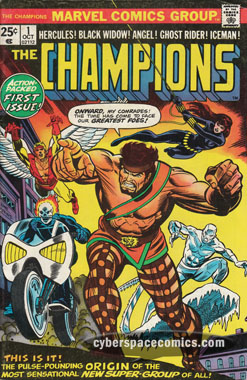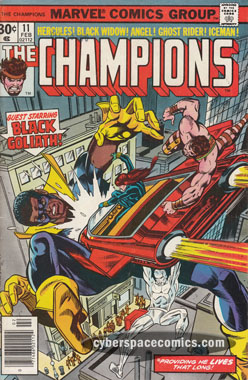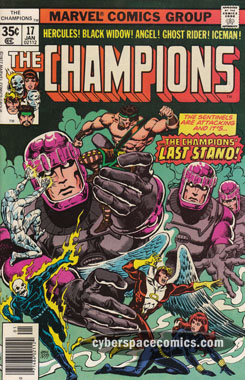With years spent reading single issues here and there, juggling storylines of dozens of titles, I decided it was time to find a better way to read comics. So, it was off to the back issue bins armed with the longest want list you’ve ever seen! Putting together series after series and reading them in their complete goodness, I was reborn as the Retro-Reader!
 Publisher: Marvel Comics
Publisher: Marvel Comics
Number of Issues: 17
First Issue: October 1975 (25¢)
Last Issue: January 1978 (35¢)
Writer: Tony Isabella (#1-2, 5-7); Bill Mantlo (#3, 8-17); Chris Claremont (#4);
Artist: Don Heck (#1-2, 5); George Tuska (#3, 4, 6, 7, 17); Bob Hall (#8-10, 16); John Byrne (#11-15)
An assertive plan by Pluto to gain power over his brother, Zeus, culminated with the kidnapping of Hercules and Venus from the UCLA campus. Angel, Iceman, Black Widow and Ghost Rider, who just so happened to be on campus at the same time, journeyed to Olympus to battle alongside Hercules and Venus against the villainous Olympians.
Following their experience in Olympus, the five heroes (Venus stayed behind) decided to band together to lend aid to the “common man”. Utilizing his newly-inherited wealth, Warren Worthington III (aka the Angel) set the team up with their very own headquarters and flying vehicle (the Champscraft). During their official debut’s press-junket, they were attacked by Darkstar, the Griffin, the Titanium Man and the Crimson Dynamo. These super-powered Russians were seeking revenge against the Black Widow’s friend and mentor, Ivan … and it was up to the Champions to defend him.
After defeating the Russians, the not-so-villainous Darkstar remained behind and joined the team in an unofficial capacity, tagging along on every other future adventure. The team also took on another unofficial member as Black Goliath joined the party in issue #11 (mere months after his own solo title was cancelled). [On a curious side note, it was revealed in the letters pages that Black Goliath was originally slated to be a member of the team but, the powers-that-be said they didn’t want a member of the team who was already headlining his own book. So who did they add in his place? Ghost Rider! And, I’m sure we all realize that the Rider was already headlining his own book …. go figure!] Along with the size-altering hero came an unresolved plot from his short-lived series. The origins of the mysterious box that had been stolen from his Stark warehouse were unveiled in a cosmic adventure that involved Kamo Tharn (the Possessor) and the Stranger!
 Finally, following battles against Swarm, Doctor Doom & Magneto, Sentinels and the Brotherhood of Evil Mutants (Blob, Lorelei, Unus the Untouchable and the Vanisher) the series came to an end with issue #17. However, the saga of the Champions did not end there. The letters pages promised that we would see them disband in a future issue of the Avengers. And, while that wasn’t exactly the case, the team’s end was shown in flashback in Peter Parker the Spectacular Spider-Man #17-18 (also written by Mantlo). Years later, the original team reunited and teamed up with X-Force (in a 1998 Annual) to fight Pluto, the Lord of Hades, yet again.
Finally, following battles against Swarm, Doctor Doom & Magneto, Sentinels and the Brotherhood of Evil Mutants (Blob, Lorelei, Unus the Untouchable and the Vanisher) the series came to an end with issue #17. However, the saga of the Champions did not end there. The letters pages promised that we would see them disband in a future issue of the Avengers. And, while that wasn’t exactly the case, the team’s end was shown in flashback in Peter Parker the Spectacular Spider-Man #17-18 (also written by Mantlo). Years later, the original team reunited and teamed up with X-Force (in a 1998 Annual) to fight Pluto, the Lord of Hades, yet again.
The Bad: As many letter-writers complained early on, this team’s existence was seemingly “pointless”. The X-Men were outcasts, the Fantastic Four were a family, the Avengers had the market cornered as “Earth’s Mightiest Heroes”, etc. Every super-team had a niche at the time … except the Champions. They just … were. Although, the writers tried to define them as the “team for the common man”, realistically, the team had no true purpose, which can be seen in all of their stories. Everything that goes on in the book happens to them. They don’t proactively embark on any of their adventures.
Another common complaint was the team’s line-up. The characters never really meshed well. Angel and Iceman were already friends (from their time in the X-Men) but none of the members seemed to form any real friendship besides the comraderie of battle. The only real ongoing characterizations were (1) Ghost Rider felt the other members were scared of him (this subplot began to build some steam just as the book was canceled) and (2) Iceman continually mused to himself that he would quit the super-hero business once the team got established.
In fact, some of the characterizations seem a bit off in this book. As mentioned previously, the fun-loving Iceman was not so fun-loving in this title. He wanted to “grow up” and quit the team and super-heroing altogether. And Hercules, known for his love of battle, ale and women was straight-laced and stern, here. Ghost Rider rarely got any spotlight (except to cry about the team being scared of him) and was even missing from some stories because he was doing other things in his own solo book, at the time.
 The series seemed to come to an abrupt end but fortunately, Mantlo dedicated two issues of his Spider-Man title to sufficiently wrap everything up.
The series seemed to come to an abrupt end but fortunately, Mantlo dedicated two issues of his Spider-Man title to sufficiently wrap everything up.
the Good: For a short-lived series, the Champions added some important bits to Marvel’s continuity. For starters, the Angel revealed his identity to the world and also got hold of his huuuuuuuge family inheritance. It also introduced the 1970s-recession-inspired villain, Rampage (who later appeared in the 1990s Wonder Man series) and Swarm (a slightly more prominent villain who’s since joined Spider-Man’s rogues gallery). It debuted some new costumes (albeit short-lived ones) for Angel and Iceman … and wrapped up a plotline that was left dangling from the Black Goliath series.
Some of John Byrne‘s earliest Marvel work can be found in the latter half of this series. It’s clearly the high-point of the book art-wise … and even storywise. At this point, Bill Mantlo had caught his stride and, with the additions of Darkstar and Black Goliath, the title was at its most fun and adventurous point.
The Verdict: Two ex-X-Men, a former Russian spy, a demigod and the spirit of vengeance. An unlikely team, to be sure. And, they certainly were! The Champions were a short-lived super-team that started out as a yawn-inducing read. Slowly but surely the book got more fun and interesting (mostly due to the creative team of Bill Mantlo and John Byrne) as the size of the team grew. But unfortunately, this strange mix of heroes just couldn’t compete with other team books at the time and the title was canceled, leaving the story to be completed elsewhere. I wouldn’t recommend sitting through the first half but #11-17 make for some fun Marvel super-hero stories.

On an interesting note, Eclipse Comics published a six issue mini-series called the Champions, based on an RPG in 1986. Marvel didn’t pursue them legally for two reasons: (A) It had been eight years since their own Champions title was published and (B) the Eclipse series was only a limited series. Well, that was a mistake on their part because the limited series paved the way for an ongoing series. Hero Comics published an ongoing series in 1987 and by that point, they’d gotten their foot in the door, legally. In 2007, when Marvel’s 50-State Initiative was in full force, they were going to reinstate the Champions as California’s official super-hero team and give them their own book. But, they quickly found out that Hero (now called Heroic Publishing) wouldn’t let them use the name … so they changed it to the Order (and it only lasted for 10 issues, anyway).
On Ebay: Marvel Comics | Champions